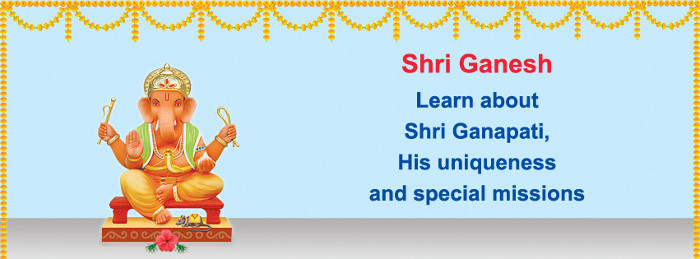
Introduction
Spirituality is a science of the subtle dimension. Hence, it is natural that spiritual knowledge be approached in a scientific way. For instance, if we are a devotee of Shri Ganapati, we should strive to obtain fundamental knowledge about Shri Ganapati from the theoretical as well as the practical aspects to generate and increase our bhav (Spiritual emotion) towards Him. It is this bhav that will enhance spiritual practice and lead to spiritual progress certainly and swiftly. This article aims to provide the devotees with some vital information on Shri Ganapati, His uniqueness and special missions in God’s Creation.
Origin & Meaning of the word Ganapati
Gana (गण) + pati (पति) = Ganapati. As per the Sanskrut language, ‘Gana’ means a ‘Pavitrak’. A ‘Pavitrak’ is the subtlemost particle of Chaitanya. ‘Pati’ is the master. Hence, ‘Ganapati’ is the master of Pavitraks.
Why is Shri Ganapati worshipped before any other Deity ?
No other Deity can arrive at the venue of worship from any direction without the permission of Shri Ganapati. Hence, Shri Ganapati is always worshipped first while performing any religious function or before worshipping any other Deity.
Once Shri Ganapati clears the directions (of obstacles), the Deity to be worshipped can come to the venue. This is called Mahadwar Puja or Mahaganapati Puja. (In the Ganapatya sect, the word Ganapati is used instead of the word ‘Brahman’ and ‘Mahaganapati’ instead of ‘Parabrahman’.)
Deity Shri Ganapati’s unique characteristics & functions
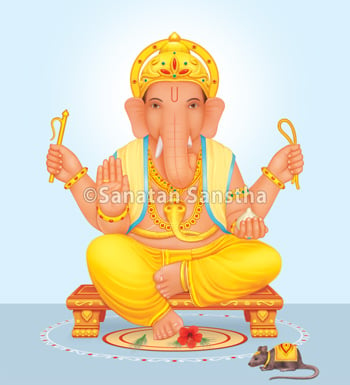
Shri Ganapati
Vighnaharta
Since He is called Vighnaharta, Shri Ganapati is worshipped before commencing any function, right from a folk dance to a wedding and all rituals including the inauguration of a house.
Amplifying the Prana-shakti (Vital energy)
Different bodily functions are carried out by different types of subtle energies. The fundamental of all these energies is called the Prana-shakti. Chanting the Name of Shri Ganapati augments the Prana-shakti in our body.
Awakens conscience and soothes the sub-conscious mind
‘Shri Ganapati absorbs the polluted energies from the universe and awakens the conscience in a person’s intellect. As a result of worshipping Shri Ganapati, the tendency to doubt does not arise. The intellect remains stable and the subconscious mind is at peace.’ – H.H. Parashram Pande Maharaj, Sanatan Ashram, Devad, Panvel, Maharashtra
Vidyapati (Presiding Deity of Knowledge)
Knowledge about any subject is first obtained through the intellect and Shri Ganapati is the bestower of intellect. That is the reason behind the ancient Bharatiya custom of writing ‘|| Shri Ganeshaya Namaha ||’ before beginning any writing; for example, a letter, an invitation to a ceremony etc. This is also the reason why, when Maharshi Vyas wanted an intelligent writer for the Mahabharat, He prayed to Shri Ganapati to undertake the task.
Converting Nadabhasha into Prakashbhasha and vice versa
Human beings speak the language of sound, that is, Nadabhasha; whereas God and Deities speak the language of light, that is, Prakashbhasha. Shri Ganapati is the Deity who can convert the language of sound into the language of light and vice versa, and conveys it to other Deities. Since Shri Ganapati comprehends the language we speak, He is also a Deity who is easily appeased.
Granting permission to take birth
Maha (An embodied soul taking birth) is born with the permission of Shri Ganapati.
Worshipped by all sects
Despite the existence of several sects, every sect in Hindu Dharma performs Shri Ganesh puja – the ritualistic worship of Shri Ganapati at the beginning of any task. In the Shaiva sect, Shri Ganapati is considered to be the son of Shiva and as chief of His attendants; whereas in the Vaishnav sect He is seen in forms like Aniruddha, Vasudev, etc. In the Shakta sect (which worships Shakti) Shri Ganapati is portrayed in the married form as Shaktiganapati or Lakshmiganapati, and is worshipped in the feminine form too. The Jain sect too performs Shri Ganesh puja.
Deity praised by Saints
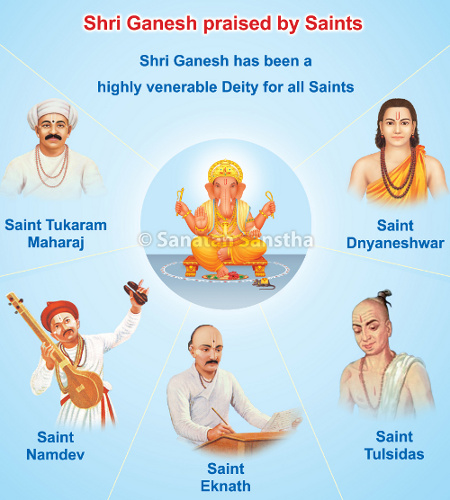
Although Saints following different paths of spiritual practice worship different Deities, all have been unanimous in their earnest prayers unto Shri Ganapati and singing His praises. Shri Ganapati has been a highly venerable Deity for revered Saints in all times, such as Saint Dnyaneshwar, Saint Eknath, Saint Tukaram Maharaj, Saint Namdev, Saint Samarth Ramdas Swami and Saint Tulsidas.
Expert in music and dance
Omkar is the manifestation of Brahman in the form of sound. Shri Ganapati is also referred to as ‘Omkar form Shri Ganapati.’ Numerous shlokas in the Shri Ganapati Varadstotra clearly illustrate the relationship of Shri Ganapati with music. The devotional songs composed by Saint Dnyaneshwar, Saint Namdev, Samarth Ramdas Swami and others also illustrate the close association of Shri Ganapati with music. We also come across Idols of Shri Ganapati in dance postures. Sage Madhva has sung praises of the treasure of dance postures possessed by Shri Ganapati. He says, “O Shri Ganapati, You are the vanquisher of all obstacles, the compassionate one, who is praised in all the three worlds and the master of dance and music.”
Vakdevta (Deity of speech)
Once blessed by Shri Ganapati, an individual attains mastery over speech.
Giving initial direction to an individual’s spiritual practice
After obtaining the above-mentioned information, it is important for the devotee of Shri Ganapati to understand the several types of effective spiritual practices they can undertake to obtain His blessings. Some methods are as follows :
1. Reciting stotras (Divine Hymns) compiled by Sages and Saints
2. Chanting potent mantras prescribed in Holy scriptures
3. Ritualistically worshipping Shri Ganesh daily
4. Celebrating annual Shri Ganesh festival in a Dharmik manner
5. Undertaking vrats (Vowed religious observances)
6. Performing mental worship
7. Informing others about the science behind Shri Ganapati’s worship
8. Protesting against malpractices taking place in festivals associated with Shri Ganapati
9. Trying to prevent the rampant denigration of Shri Ganapati through various mediums
All the above-mentioned methods are effective in raising our understanding of Shri Ganapati Principle.
Tithi associated with Shri Ganapati : Chaturthi
The tithi, that is, the date as per the Hindu lunar calendar on which the frequencies of Shri Ganapati Principle descended on Earth for the first time was chaturthi. Hence on chaturthi the vibrations of Shri Ganapati come on the Earth in higher proportion.
On the day of chaturthi of every month, the Ganesh Principle is hundred times more active on Earth than usual. The worship of Shri Ganesh ji performed on this day gives more spiritual benefit of Shri Ganesh Principle.
In every month there are two chaturthis.
A) The Vinayaki chaturthi that falls in the bright fortnight of the month, that is, Shuklapaksha
B) The Sankashti chaturthi that falls in the dark fortnight of the month, that is, Krushnapaksha
The chaturthi that falls on a Tuesday is called ‘Angaraki chaturthi’.
Shri Ganeshopasana
Every person worships Shri Ganesh ji in various forms according to his faith. Many actions are included in the worship of Shri Ganesha ji. Some people utter the thousands Names of Shri Ganesh ji one by one and offer the fragrant grass, that is, Durva to Him along with each Name. This is called ‘durvachan’. There are two types of Shri Ganesh ji idols
A) Dakshinabhimukhi means the idol whose trunk is curved towards the right side. South means the right side. One who is able to face the south direction leading to the region of Deity Yama is powerful and One with an activated Surya nadi (Sun channel) is radiant. Thus in both senses, the Dakshinabhimukhi Ganapati is said to be ‘awakened’. The ritualistic worship of the Dakshinabhimukhi idol is performed by meticulously observing all the rules of the rituals.
B) Vam means the left side. Mostly the vamamukhi idols are used for worship. The trunk of the idol is curved towards the left side.
Daily worship of Shri Ganapati
A) Apply the sandalwood paste to Shri Ganapati with the ring finger.
B) Offer the hina scent.
C) Offer the Durva grass to Shri Ganapati.
D) Offer eight red flowers with the stems facing Shri Ganapati.
E) Offer two lit incense-sticks.
F) Offer the Holy sacrament (naivedya) of Modak to Shri Ganapati.
G) Offer the arati to Shri Ganapati three times in a clock-wise direction.
H) Perform minimum eight circumambulations (parikrama) around Shri Ganapati. If this is not possible, perform three circumambulations by revolving around yourself.
Special substances used in the worship of Shri Ganapati
In the worship of Shri Ganesh, the Durva grass, the leaves of Shami and Mandar, objects of red or saffron colour like Raktachandan, red or saffron coloured cloth and flower are specially used.
In order to get more spiritual benefit of Shri Ganesh Principle, the use of incense sticks of sandalwood, kevada, jasmine and khas fragrance is beneficial
After the ritualistic worship, modaks are offered to Shri Ganapati as a Holy sacrament and kheer to the mouse, His vehicle.
Spiritual experience – Ganesh Principle being absorbed in higher proportion because of wearing of a red-coloured saree: On 2nd October 2006 after wearing a red-coloured saree with a zari border, I experienced that a spiral of Ganesh Principle was revolving around me. I became intensely conscious that due to wearing of a red-coloured saree, the Ganesh Principle was being absorbed in higher proportion. My devotion, spiritual emotion and Anand increased. This state lasted for four hours – Ms. Smita Joshi, Maharashtra.
Ruddhi-Siddhi the consorts of Shri Ganesh
Flow and counterflow of energy and Shri Ganesh’s Riddhi-Siddhi
‘Energies flowing towards the earth are called ‘prasav kram’ and those flowing towards the soul are called ‘pratiprasav kram’. It is based on this that Shri Ganesh is called the patron of Riddhi and Siddhi.
1. Riddhi
Whenever this energy or Shri Ganesh become extrovert and gets activated, the embodied soul performs worldly actions and this energy is said to be attained.
2. Siddhi
Whenever this energy or Shri Ganesh becomes introvert, gets activated and flows, the path of the embodied soul expands with the objective of attaining a supernatural state of the soul.
Who started the practice of pradakshina (Circumambulation) ?
As per Purans (eighteen sacred Holy texts compiled by Sage Vyas) Shri Ganesh the bestower of intellect was the first to circumambulate Shiva and Parvati, His parents.
Shri Ganapati is easily pleased and fulfil desires fast in the Kaliyug (Era of strife) ?
In the Kaliyug only two Deities are easily pleased and fulfil desires fast ‘कलौ चंडिविनायकौ –Chandi Devi and Vinayak, that is Ganapati.
Greater details on Ganesh are given in the Ganesh Puran, Mudgal Puran, Ganesh Mahatmya, Padmapuran, Bhavishyottar Puran, Lingapuran, Brahmavaivartapuran and Shivapuran. Some references are found in the Mahabharat. But this is a Vedic Deity and His refence in the Vedant is as follows.
1. ‘गणानां त्वा गणपतिं हवामहे ।
कविं कवीनामुपश्रवस्तमम… ।’ – Rugveda
2. ‘गणानां त्वा गणपतिं हवामहे’
प्रियाणां त्वा प्रियपतिं हवामहे… ।’ – Atharvashirsha from Atharvaveda
This is how Shri Ganesh performed the seva of writing the Mahabharat for Sage Vyas
‘Sage Vyas told Shri Ganesh at Yaval that He would have to write what he says continuously, without stopping. Sage Vyas began His narration and Shri Ganesh kept writing. His pen suddenly got spoilt but since He had been told that He should not stop, He quickly broke one tusk and continued writing with it. Ever since He is called Ekadanta (the one with one tusk).’ – Mr. Tukaram Joshi, Shivajinagar, Vada (Thane) (Akkalkot Swami Darshan, year 33, Issue 4)

 Maghi Shri Ganesh Jayanti 2025
Maghi Shri Ganesh Jayanti 2025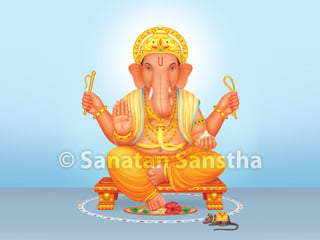 Sankashtnashan Stotra
Sankashtnashan Stotra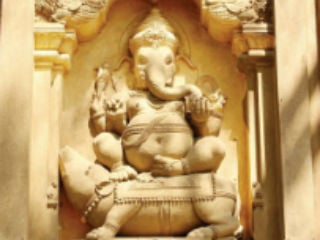 Signs of ancient Hindu culture left behind in foreign lands
Signs of ancient Hindu culture left behind in foreign lands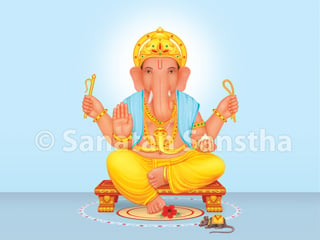 Some mantras to be recited when worshipping Shri Ganesh with specific objectives
Some mantras to be recited when worshipping Shri Ganesh with specific objectives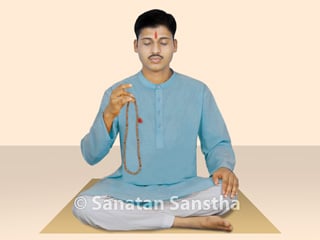 Chants of Shri Ganesh
Chants of Shri Ganesh